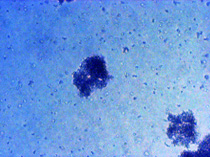Literature overview cell culture contamination
On this page, we are collecting links to interesting papers and publication about cell culture contaminations such as bacteria, mycooplasma, yeast, funghi etc. This list is continously growing. A good overview article is this one:
Cell culture contamination: an overview.
Langdon SP.: Methods Mol Med 2004;88:309-17. Review
Articles about bacterial contamination in cell culture
Bacterial contaminations are found in all areas of cell culture. In research labs at universities and companies but also in industrial production facilities using cells in their processes or the now growing field of clinical reasearch aiming at the devleopment of advanced therapy medicinal products (ATMP) or tissue engineered products (TEMP, TEP). In the following parts, we have tried to list papers sorted by the field of application.
Bacteria in clinical samples
|
Risk factors for microbial contamination of peripheral blood stem cell products. Donmez A, Aydemir S, Arik B, Tunger A, Cilli F, Orman M, Tombuloglu M.: Transfusion 2012 Apr;52(4):777-81.
|
 |
Eder AF, Kennedy JM, Dy BA, Notari EP, Skeate R, Bachowski G, Mair DC, Webb JS, Wagner SJ, Dodd RY, Benjamin RJ (American Red Cross Regional Blood Centers): Transfusion 2009 Aug;49(8):1554-63.
- contamination safety was compared after changing preparation procedure and increasing test-sample volumes
- in part, contaminants found belonged to skin-flora
- before changes, 25.9% of samples were found contamination-positive
- after changes, this was reduced to 14% contamination-positive cultures
- doubling the sample culture volume increased safety by 54%
Brecher ME, Means N, Jere CS, Heath D, Rothenberg S, Stutzman LC.: Transfusion 2001 Apr;41(4):477-82.
- 24h cultivation time seems necessary for safe detection


